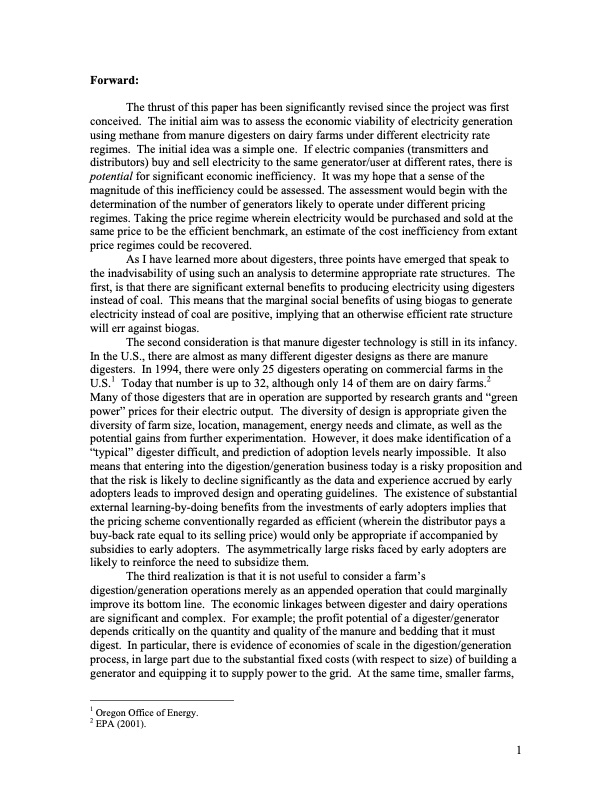
PDF Publication Title:
Text from PDF Page: 002
Forward: The thrust of this paper has been significantly revised since the project was first conceived. The initial aim was to assess the economic viability of electricity generation using methane from manure digesters on dairy farms under different electricity rate regimes. The initial idea was a simple one. If electric companies (transmitters and distributors) buy and sell electricity to the same generator/user at different rates, there is potential for significant economic inefficiency. It was my hope that a sense of the magnitude of this inefficiency could be assessed. The assessment would begin with the determination of the number of generators likely to operate under different pricing regimes. Taking the price regime wherein electricity would be purchased and sold at the same price to be the efficient benchmark, an estimate of the cost inefficiency from extant price regimes could be recovered. As I have learned more about digesters, three points have emerged that speak to the inadvisability of using such an analysis to determine appropriate rate structures. The first, is that there are significant external benefits to producing electricity using digesters instead of coal. This means that the marginal social benefits of using biogas to generate electricity instead of coal are positive, implying that an otherwise efficient rate structure will err against biogas. The second consideration is that manure digester technology is still in its infancy. In the U.S., there are almost as many different digester designs as there are manure digesters. In 1994, there were only 25 digesters operating on commercial farms in the U.S.1 Today that number is up to 32, although only 14 of them are on dairy farms.2 Many of those digesters that are in operation are supported by research grants and “green power” prices for their electric output. The diversity of design is appropriate given the diversity of farm size, location, management, energy needs and climate, as well as the potential gains from further experimentation. However, it does make identification of a “typical” digester difficult, and prediction of adoption levels nearly impossible. It also means that entering into the digestion/generation business today is a risky proposition and that the risk is likely to decline significantly as the data and experience accrued by early adopters leads to improved design and operating guidelines. The existence of substantial external learning-by-doing benefits from the investments of early adopters implies that the pricing scheme conventionally regarded as efficient (wherein the distributor pays a buy-back rate equal to its selling price) would only be appropriate if accompanied by subsidies to early adopters. The asymmetrically large risks faced by early adopters are likely to reinforce the need to subsidize them. The third realization is that it is not useful to consider a farm’s digestion/generation operations merely as an appended operation that could marginally improve its bottom line. The economic linkages between digester and dairy operations are significant and complex. For example; the profit potential of a digester/generator depends critically on the quantity and quality of the manure and bedding that it must digest. In particular, there is evidence of economies of scale in the digestion/generation process, in large part due to the substantial fixed costs (with respect to size) of building a generator and equipping it to supply power to the grid. At the same time, smaller farms, 1 Oregon Office of Energy. 2 EPA (2001). 1PDF Image | The Economics and Feasibility of Electricity Generation using Manure Digesters on Small and Mid-size Dairy Farms

PDF Search Title:
The Economics and Feasibility of Electricity Generation using Manure Digesters on Small and Mid-size Dairy FarmsOriginal File Name Searched:
Biogas_Economics_Mehta.pdfDIY PDF Search: Google It | Yahoo | Bing
Capstone Turbine and Microturbine: Capstone microturbines used and new surplus for sale listing More Info
Consulting and Strategy Services: Need help with Capstone Turbine, sizing systems, applications, or renewable energy strategy, we are here to assist More Info
Container Lumber Dry Kiln: Since 1991 developing and innovating dry kilns using standard shipping containers More Info
Supercritical CO2 Lumber Dry Kiln: Compact fast drying in 3 days or less for small amounts of wood and lumber drying More Info
BitCoin Mining: Bitcoin Mining and Cryptocurrency... More Info
Publications: Capstone Turbine publications for microturbine and distributed energy More Info
FileMaker Software for Renewable Energy Developing database software for the renewable energy industry More Info
CO2 Gas to Liquids On-Demand Production Cart Developing a supercritical CO2 to alcohol on-demand production system (via Nafion reverse fuel cell) More Info
Stranded Gas for low cost power Bitcoin Mining Using stranded gas for generators may provide breakthrough low power costs for cryptocurrency miners. More Info
| CONTACT TEL: 608-238-6001 Email: greg@globalmicroturbine.com | RSS | AMP |